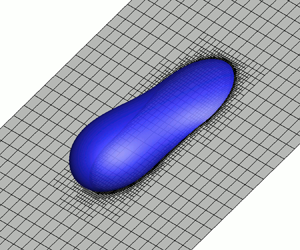Crossref Citations
This article has been cited by the following publications. This list is generated based on data provided by
Crossref.
Zhang, Jiaqi
and
Yue, Pengtao
2020.
A level-set method for moving contact lines with contact angle hysteresis.
Journal of Computational Physics,
Vol. 418,
Issue. ,
p.
109636.
Hashemi, Mohammad R.
Ryzhakov, Pavel B.
and
Rossi, Riccardo
2021.
Toward droplet dynamics simulation in polymer electrolyte membrane fuel cells: Three-dimensional numerical modeling of confined water droplets with dynamic contact angle and hysteresis.
Physics of Fluids,
Vol. 33,
Issue. 12,
Dadvand, Abdolrahman
Bagheri, Milad
Samkhaniani, Nima
Marschall, Holger
and
Wörner, Martin
2021.
Advected phase-field method for bounded solution of the Cahn–Hilliard Navier–Stokes equations.
Physics of Fluids,
Vol. 33,
Issue. 5,
Prasad, K.K.
Roy, T.
Goud, M.M.
Karar, Vinod
and
Mishra, Vinod
2021.
Diamond turned hierarchically textured surface for inducing water repellency: Analytical model and experimental investigations.
International Journal of Mechanical Sciences,
Vol. 193,
Issue. ,
p.
106140.
Wu, Yanchen
Kuzina, Mariia
Wang, Fei
Reischl, Markus
Selzer, Michael
Nestler, Britta
and
Levkin, Pavel A.
2022.
Equilibrium droplet shapes on chemically patterned surfaces: theoretical calculation, phase-field simulation, and experiments.
Journal of Colloid and Interface Science,
Vol. 606,
Issue. ,
p.
1077.
Shen, Mingguang
and
Li, Ben Q.
2022.
A Phase Field Approach to Modeling Heavy Metal Impact in Plasma Spraying.
Coatings,
Vol. 12,
Issue. 10,
p.
1383.
Amberg, Gustav
2022.
Detailed modelling of contact line motion in oscillatory wetting.
npj Microgravity,
Vol. 8,
Issue. 1,
Huang, Ziyang
Lin, Guang
and
Ardekani, Arezoo M.
2022.
Implementing contact angle boundary conditions for second-order Phase-Field models of wall-bounded multiphase flows.
Journal of Computational Physics,
Vol. 471,
Issue. ,
p.
111619.
Pan, Yuming
Wang, Zhibei
Zhao, Xinyan
Deng, Weiwei
and
Xia, Huihui
2022.
On axisymmetric dynamic spin coating with a single drop of ethanol.
Journal of Fluid Mechanics,
Vol. 951,
Issue. ,
Afkhami, Shahriar
2022.
Challenges of numerical simulation of dynamic wetting phenomena: a review.
Current Opinion in Colloid & Interface Science,
Vol. 57,
Issue. ,
p.
101523.
Xiao, Yao
Zeng, Zhong
Zhang, Liangqi
Wang, Jingzhu
Wang, Yiwei
Liu, Hao
and
Huang, Chenguang
2022.
A spectral element-based phase field method for incompressible two-phase flows.
Physics of Fluids,
Vol. 34,
Issue. 2,
Bazesefidpar, Kazem
Brandt, Luca
and
Tammisola, Outi
2022.
Numerical simulation of the coalescence-induced polymeric droplet jumping on superhydrophobic surfaces.
Journal of Non-Newtonian Fluid Mechanics,
Vol. 307,
Issue. ,
p.
104872.
Zhang, Zhen
and
Xu, Xianmin
2022.
Effective boundary conditions for dynamic contact angle hysteresis on chemically inhomogeneous surfaces.
Journal of Fluid Mechanics,
Vol. 935,
Issue. ,
Pathak, Ashish
Jin, Wen
and
Raessi, Mehdi
2023.
A three-dimensional numerical scheme for modeling discontinuous pinning at sharp edges using the Volume-of-Fluid method.
Journal of Computational Physics,
Vol. 479,
Issue. ,
p.
111986.
Wang, Fei
Zhang, Haodong
Wu, Yanchen
and
Nestler, Britta
2023.
A thermodynamically consistent diffuse interface model for the wetting phenomenon of miscible and immiscible ternary fluids.
Journal of Fluid Mechanics,
Vol. 970,
Issue. ,
Bodziony, Francisco
Wörner, Martin
and
Marschall, Holger
2023.
The stressful way of droplets along single-fiber strands: A computational analysis.
Physics of Fluids,
Vol. 35,
Issue. 1,
Zhao, Chunheng
Limare, Alexandre
and
Zaleski, Stephane
2023.
General wetting energy boundary condition in a fully explicit nonideal fluids solver.
Physical Review E,
Vol. 108,
Issue. 5,
Zhang, Hongmin
Wu, Yanchen
Wang, Fei
and
Nestler, Britta
2023.
Effect of wall free energy formulation on the wetting phenomenon: Conservative Allen–Cahn model.
The Journal of Chemical Physics,
Vol. 159,
Issue. 16,
Alam, Md. Nur E.
and
Tan, Hua
2023.
Droplet impact on a microhole through a partially wetting surface.
Physics of Fluids,
Vol. 35,
Issue. 10,
Shen, Mingguang
and
Li, Ben Q.
2023.
A 3D conservative level set model to simulate drop impact with phase change onto solid surfaces.
International Journal of Multiphase Flow,
Vol. 169,
Issue. ,
p.
104615.
